Blue Male Crowntail Betta Fish Petsmart Fish Food
Please note: this page contains affiliate links
If you're wondering what betta fish food, or how much and how often, you're not alone. Surprisingly this is one of the most frequent questions when it comes to first-time betta keeping, and overfeeding is very common! To further complicate things, it's not always wise to rely on the information from pet stores or on the food product labels either.
Bettas can be downright picky eaters too and tend to prefer eating food on the surface of the water instead of on the substrate of a tank. Bettas require a well-balanced diet that is rich in protein because they are primarily carnivores. It's a myth that bettas can survive simply by feeding on the roots of plants.
Most betta keepers decide to feed pellets because they are simple and effective. Pellets create less mess and you can easily portion them out for feedings. Live, freeze-dried, or frozen foods can be used as treats or implemented into their daily feeding routine too.
To keep your betta happy and healthy please follow each food and feeding guideline below as these tips could literally save your fish's life:
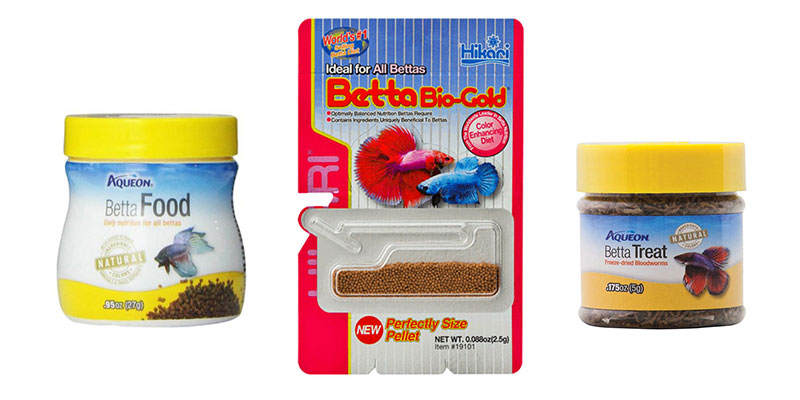
Best Betta Fish Food: Dietary Requirements
Betta fish are classified as carnivores, and eat insects in the wild. The best betta food replicates these specific dietary needs without a lot of added and indigestible fillers. For most betta keepers it may not be possible to source or provide live foods as a betta fish's main diet. It's best then, to provide a variety of high-quality pellets, flakes, freeze dried, frozen and live foods. Each is covered below.
Providing the best nutritional value focuses on a betta's need of protein, fat, fiber, phosphorus, carbohydrates, calcium, and vitamins (A, D3, E, K, B1, B2, B3, B5, B6, B12, C, H, M). Make sure your betta food is natural and contains protein as the first ingredient. Do not purchase or feed flakes made for goldfish or other tropical fish.
Betta fish have very short digestive tracts and do not process fillers like corn and wheat very well. These fillers are often found in many pellet and flake foods and can lead to excess bloat and digestive issues (e.g. constipation). Betta's receive no nutritional benefit from fillers and just pass them off as waste. It's very important you provide foods high in protein to satisfy their carnivorous needs. Fiber and moisture are also important to aid their digestion.
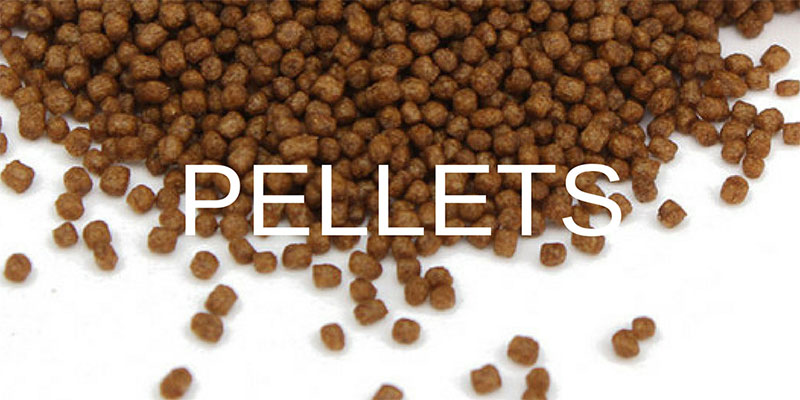
Betta Fish Pellets
Pellets are the most common betta fish food on the market, with quality varying greatly across each. The best pellets for betta fish will have fewer fillers and more high-quality ingredients that help fish thrive. Some betta fish pellets expand significantly after they are exposed to water.
This can cause bloating and digestive issues if you're not careful as they'll expand in your betta's stomach. For pellets that expand once wet, soak them in tank water before feeding to hydrate them, especially if your betta attacks food instantly.
| Picture | Name | Analysis | Pros | Cons | Price | Rating |
|---|---|---|---|---|---|---|
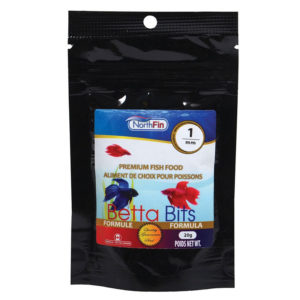 | NorthFin Betta Bits | -Crude Protein (min): 45% -Crude Fat (min): 16% -Crude Fiber (min): 4% -Moisture (max): 9% -Ash (max): 10% | -No fillers or hormones -No dyes or artificial coloring -Ideal 1mm size | - May be hard to find, except online | $$$$ | 5.0 |
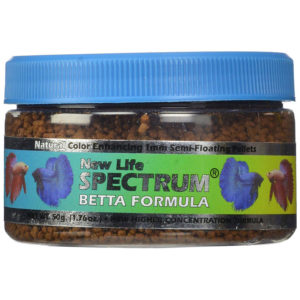 | New Life Spectrum Betta Formula | -Crude Protein (min): 37% -Crude Fat (min): 5% -Crude Fiber (max): 4% -Moisture (max): 10% -Ash (max): 8% | -Color enhancing ingredients -Doesn't expand -High-quality ingredients -Almost no fillers -Does not cloud water | -Semi-floating may easily sink -Inconsistent pellet sizing | $$ | 4.7 |
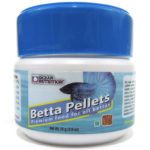 | Ocean Nutrition Betta Pellets | Crude Protein (min): 36% Crude Fat (min): 4.5% Crude Fiber (max): 5% Moisture (max): 8% Ash (max): 15% | -High in vitamins and protein -Small size and easy to digest -Does not cloud water -Color enhancing | -Large quantity -Freshness may expire before using -May not float for very long | $$$ | 4.4 |
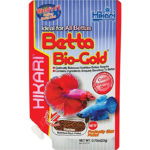 | Hikari Betta Bio-Gold | -Crude Protein (min): 38% -Crude Fat (min): 4% -Crude Fiber (min): 3% -Moisture (max): 10% -Ash (max): 12% | -Color enhancing ingredients -Small-sized pellets | -Fillers and artificial coloring -Difficulty dispensing | $$$ | 4.1 |
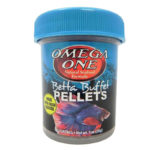 | Omega One Betta Buffet Pellets | -Crude Protein (min): 40% -Crude Fat (min): 5% -Crude Fiber (min): 2% -Moisture (max): 8.5% -Ash (max): 8% | -High in crude protein -Primary ingredient is salmon -Low in ash -Smaller pellet size | -Does not float for very long -Fillers and artificial colors -Pellet size may be inconsistent | $$ | 3.8 |
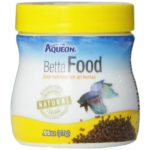 | Aqueon Betta Food | -Crude Protein (min): 38% -Crude Fat (min): 7% -Crude Fiber (max): 7% -Moisture (max): 8% -Phosphorous (min): 1% | -Small pellet size -Comes in color enhancing blend -Inexpensive | -A lot of fillers -Does not float very long -Tiny pellets | $ | 3.4 |
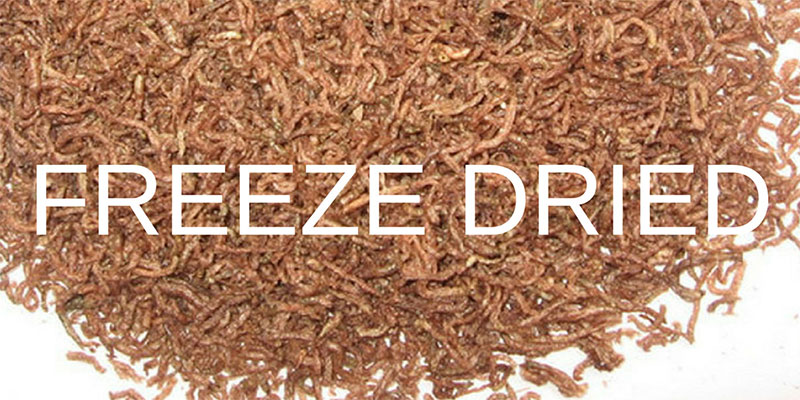
Freeze-Dried Betta Food
Freeze dried food is a great option to introduce some of the betta's natural food into their diet, but it does not replace the quality of live or frozen foods. Freeze dried foods have been stripped of their moisture and have added fillers to keep them stable.
It's recommended that you soak them in tank water before feeding to rehydrate them, increasing the moisture content. Feeding only freeze dried food can lead to bloating and constipation issues.
One large benefit to freeze dried foods, however, is they are free of bacteria and parasites.They are also easy to find at local fish stores and online and are relatively inexpensive. They store well and often come in your typical fish food containers.
| Picture | Name | Analysis | Price | Rating |
|---|---|---|---|---|
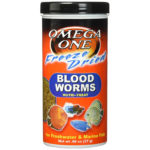 | Omega One Freeze-Dried Bloodworms | -Crude Protein (min): 55% -Crude Fat (min): 3% -Crude Fiber (max): 5% -Moisture (max): 5% | $$$ | 4.5 |
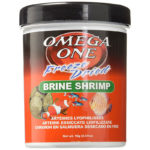 | Omega One Freeze-Dried Brine Shrimp | -Crude Protein (min): 48% -Crude Fat (min): 6% -Crude Fiber (max): 2.5% -Moisture (max): 5% | $$$ | 4.2 |
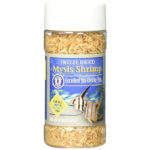 | San Francisco Bay Brands Freeze-Dried Mysis Shrimp | -Crude Protein (min): 67.3% -Crude Fat (min): 5% -Crude Fiber (max): 2.8% -Moisture (max): 8.4% -Ash (max): 10.8% | $$$ | 4.8 |
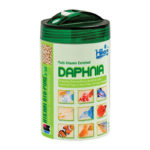 | Hikari Freeze-Dried Daphnia | -Crude Protein (min): 66% -Crude Fat (min): 9% -Crude Fiber (max): 5% -Moisture (max): 7% | $$$$ | 5.0 |
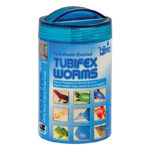 | Hikari Freeze-Dried Tubifex Worms | -Crude Protein (min): 60% -Crude Fat (min): 6.5% -Crude Fiber (max): 0.3% -Moisture (max): 6% | $$$ | 4.3 |
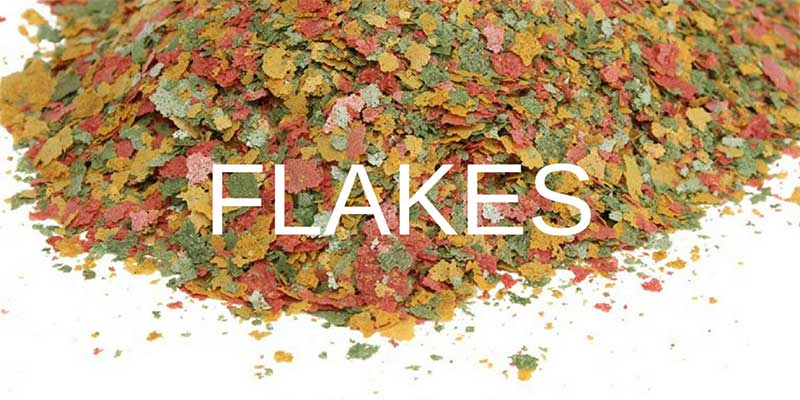
Betta Fish Flakes
There are specific flakes made specifically for betta fish. Do not feed your betta other tropical fish flakes because they lack the protein requirements bettas need. Betta flakes can be a staple in regular feedings, but they can also be very messy. Excess or sunken flakes should be removed immediately after feeding. Betta fish often refuse to eat flakes as well.
| Picture | Name | Analysis | Price | Rating |
|---|---|---|---|---|
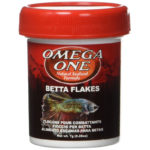 | Omega One Betta Flakes | -Crude Protein (min): 43% -Crude Fat (min): 12% -Crude Fiber (max): 2% -Moisture (max): 8.5% -Ash (max): 8% | $$ | 3.1 |
 | Tetra BettaMin | -Crude Protein (min): 48% -Crude Fat (min): 8.5% -Crude Fiber (max): 1.5% -Moisture (max): 7% -Phosphorus (min): 1.1% | $$ | 2.5 |

Live & Frozen Betta Food
If you've never fed your betta anything other than pellets then you and your betta are missing out. Betta fish are carnivores and they get increasingly aggressive during feedings when they have to stalk their prey. This is also the best way to replicate their natural habitat and food sources.
Some are harder to source than others but make for a balanced diet. Be careful of where you source your live and frozen foods from, as they may carry parasites and other diseases. Never feed your betta something you caught outdoors either.
Frozen foods come in many of the same options. It's a great alternative to keeping live food. Frozen betta food may be kept in your freezer until you're ready to defrost and feed them to your betta. Only take as much as you need placing the rest back into the freezer to prevent thawing. Never refreeze any food that has been thawed as it could have been exposed to bacteria.
These options below are a betta's favorites:
1. Live/Frozen Mosquito Larvae
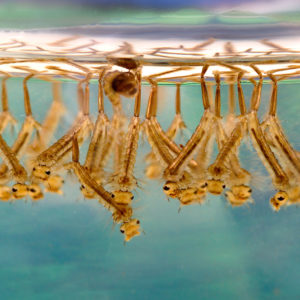
A staple in their natural habitat, mosquito larvae are an excellent betta food option. While they may be hard to source during the winter months, mosquitos and their larvae are very active and abundant during spring and summer and in warmer climates. Purchase a starter culture and harvest them yourself, or find a reputable local or online store that carries them.
2. Live/Frozen Brine Shrimp
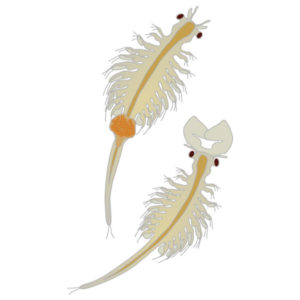
Brine shrimp are an aquatic crustacean that betta fish love. The photo above is zoomed in, from the University of Utah, they only grow up to 1 centimeter as adults. Brine shrimp are packed with the nutritional needs that betta fish need to thrive on (proteins, vitamins, and amino acids), and they're easy to raise too. They can also be found at most local fish stores, making them a good option for varying up your betta's diet.
3. Live/Frozen Bloodworms
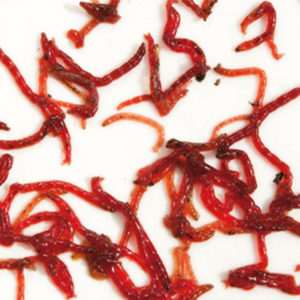
Bloodworms or Glycera are the larvae of the midge fly and can be found in pools and ponds of water. Betta fish commonly gorge on them in the wild, making them ideal variations for even the pickiest of eaters. Betta's put on a big show when going after these guys, but they shouldn't be used as the exclusive source of food because they lack amino acids. They are high in iron content, resulting in their bright red coloring. If you can't handle the live option (they are pretty gross looking), they also come in a gel or freeze-dried option.
4. Live/Frozen Wingless Fruit Flies
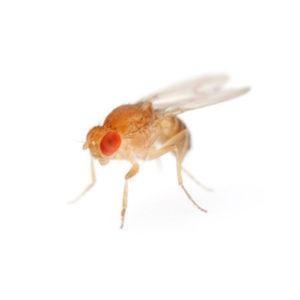
Also known as the vinegar fly, the common fruit fly is something you are probably very familiar with. Have you ever left bananas, apples or other fruit out in your kitchen, and all of a sudden there's swarms of little bugs flying around them? Those are fruit flies and betta fish love them because they are insectivores. While you can technically drop them in for feeding, you don't know what diseases they may have and they may fly out. Instead, there is a wingless and flightless variety that is ideal for feeding betta fish and can even be bred and harvested in a small container inexpensively.
5. Live/Frozen Mysis Shrimp
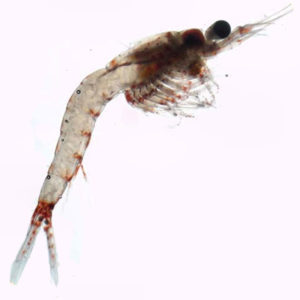
Mysis shrimp, or opossum shrimp, are another great option for betta fish because of their exoskeleton. This exterior is rich in fiber, which aids the digestion of protein-rich foods. If your betta fish is a picky eater, these guys might do the trick for some variety. They are packed with betta-loving nutrients, more so than brine shrimp, and are also high in moisture and amino acids.
How Much & How Often to Feed a Betta Fish?
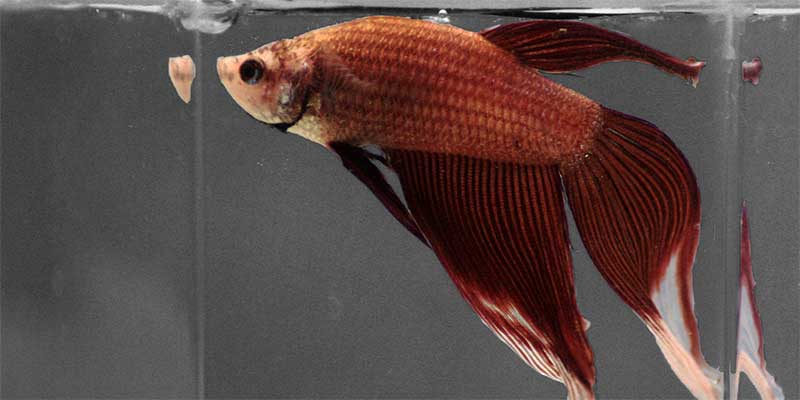
Pay no attention to the amount and instructions on the side of the betta fish food can. These directions are often very misleading and can cause problems with your betta and the water quality in your tank. Typical feeding instructions say to feed as much as your fish will consume in 5 minutes, or to feed several times daily in amounts that can be consumed in 3 minutes. This is not recommended and will lead to overfeeding and excess waste.
- Betta fish pellets (2-4 pellets, 1-2 times daily)
- Live, frozen, or freeze-dried (2-3 pieces, 1-2 times daily)
Adult bettas can be fed once per day, and babies (fry) can be fed twice per day. It might not seem like enough, but many pellets expand to more than 2X their size once they get wet. To put this into further perspective, a betta fish's stomach is roughly the size of their eye! Additional feedings may be necessary depending on the activity level and personality of your betta.
Bettas will overeat if you let them. Overfeeding and overeating can lead to constipation, bloating, obesity (that's right betta fish can get fat), swim bladder problems, contracting diseases because of the bacteria feeding on the excess food breaking down, and even death.
Ideal Feeding Schedule:
- Monday: Betta fish pellets (2-4 pellets, 1-2 times daily)
- Tuesday: Live, frozen, or freeze-dried (2-3 pieces, 1-2 times daily)
- Wednesday: Betta fish pellets (2-4 pellets, 1-2 times daily)
- Thursday: Betta fish pellets (2-4 pellets, 1-2 times daily)
- Friday: Live, frozen, or freeze-dried (2-3 pieces, 1-2 times daily)
- Saturday: Betta fish pellets (2-4 pellets, 1-2 times daily)
- Sunday: Fast to keep digestive regularity
Always clean up any excess food that falls to the bottom of the tank with an aquarium designated turkey baster. This will prevent ammonia buildup and the potential for harmful diseases being present from food decay.
It's also a good idea to not feed your betta one day per week, this gives their digestive tract time to fully process food and it limits problems associated with overeating. If you're going to be gone for a day or two, or on vacation, don't pour extra betta food in either.
Extra feeding will lead to overeating or they may not eat the excess at all. If you want to know how long betta fish can go without food too, it's actually 14 days. Therefore, it's always better not to feed your betta over the weekend or for a day or two than it is to feed them extra.
What If Your Betta Fish Won't Eat?
If your betta fish won't eat or seems completely uninterested in food don't worry. A lack of appetite may mean that they are not hungry or have recently undergone some type of stress (e.g. tank cleaning, new home, abrupt water temperature changes). Again, don't worry about a couple days because bettas can survive up to 14 days without food.
Cold water that is outside of the recommended range of 76-81 degrees Fahrenheit may also cause your betta to act lethargic and will slow their metabolism. A lower metabolism means they will need fewer feedings. As betta fish get older they will also be less active and may eat less frequently, this is normal.
If your betta isn't eating it may also be a sign of illness. Just like when we are sick, betta fish also won't have big appetites while they are ill. Make sure to monitor for signs of illness and disease, and initiate the proper treatments as soon as possible.
Once a betta recovers, their appetite will also begin to come back too. As mentioned above bettas can be picky too. If you notice your betta fish spitting out his or her food, or turns away from it, you may need to try a different kind or brand.
Recap
That's a lot of information to digest, but as a betta keeper, it is our responsibility to make sure they have a well-balanced diet for optimal health. Myths exist regarding live foods causing constipation and bloating. This can happen, but it's normally from a lack of fiber in the betta's diet, or overfeeding.
Remember, betta fish may eat even if they are not hungry. In the wild, betta fish may not know when their next meal is, so their instinct is to continue eating while food is available.
Ranked in order, the best betta food is live, frozen, freeze-dried, pellets, and flakes. Feeding a variety of different foods will provide the array of nutrients a betta fish needs to thrive.
How much to feed your betta fish can depend on their individual activity level, but 2-3 pellets 1-2 times daily is a safe amount. Get in the habit of sticking to a regular feeding schedule so that you don't forget whether or not you fed them.
Please ask any questions you may still have about specific betta fish food and feeding procedures in the comments below.
Source: https://bettafish.org/care/food-feeding/
Enregistrer un commentaire for "Blue Male Crowntail Betta Fish Petsmart Fish Food"